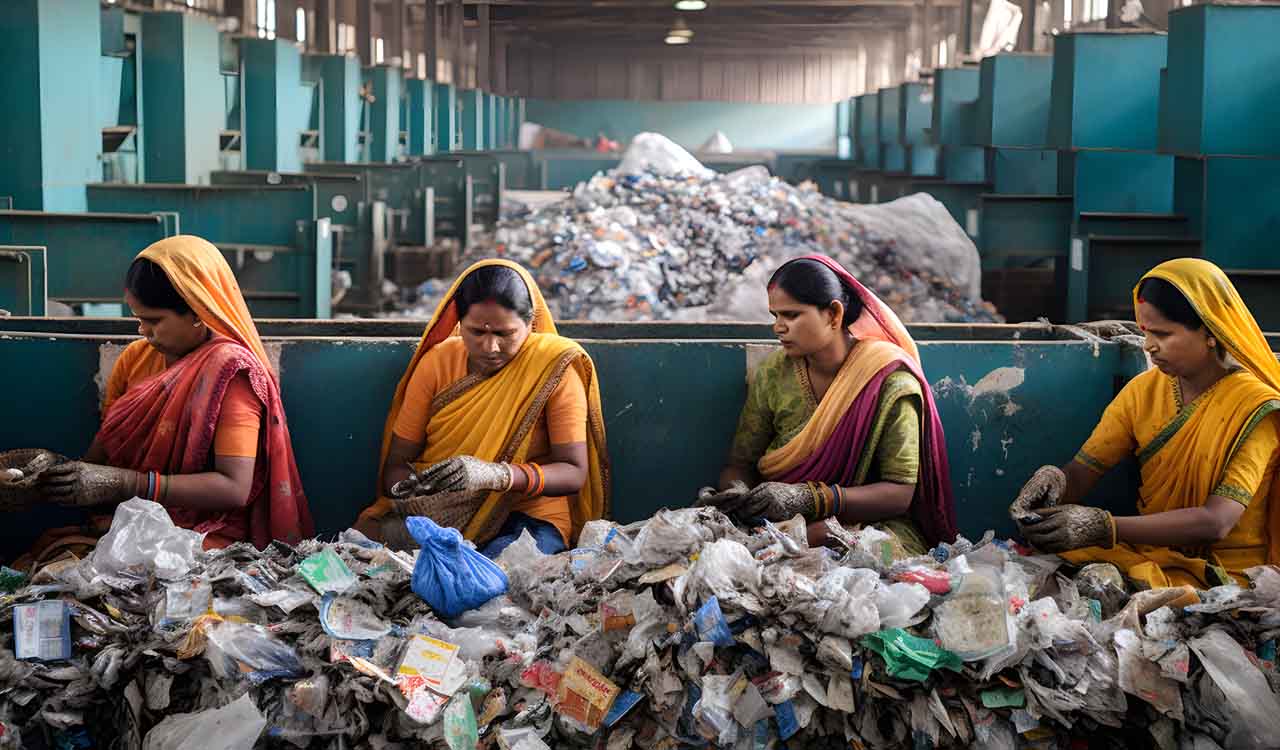Opinion: India must build a truly circular economy

While India has signalled bold ambitions to embrace circularity, the path remains strewn with policy bottlenecks, capacity gaps and systemic inertia
Published Date – 12 May 2025, 08:31 PM

By Sarmistha Mishra, Souryabrata Mohapatra
By 2030, India is poised to become the world’s third-largest economy. Yet, amid this remarkable ascent lies a growing mountain — of garbage. India generates 1,60,038 tonnes of waste per day (TPD), but only half of this is treated. A staggering 29,427 TPD is dumped in landfills, while nearly 51,000 TPD disappears unaccounted for. These numbers speak not just of poor waste management but also of an economic model that’s still stuck in a linear loop of “take, make, dispose.”
The circular economy (CE) — a model that designs out waste and pollution, keeps products and materials in use and regenerates natural systems — is no longer a theoretical ideal. It is a practical necessity. Yet, while India has signalled bold ambitions to embrace circularity, the path remains strewn with policy bottlenecks, capacity gaps and systemic inertia.
Promise and Problem
India’s policy discourse on circularity has expanded in recent years. From the Extended Producer Responsibility (EPR) rules to flagship forums like CITIIS 2.0 and the 12th Regional 3R and CE Forum hosted in Jaipur, the government has sent strong signals about its intentions. In 2024 alone, CITIIS projects worth over Rs 1,800 crore were signed, with 18 cities selected for ‘Lighthouse Projects’ to integrate CE into urban planning.
However, these efforts remain isolated. The Central Pollution Control Board reports that 31.7% of India’s municipal solid waste remains untraced. Delhi, India’s capital, presents a grotesque symbol of this failure. The Ghazipur landfill alone emits 15.3 Gg (greenhouse gas) of methane annually —1-3% of India’s total landfills emit methane — posing grave health and environmental risks.
What plagues India’s transition is not a lack of ambition but fragmented execution. State and municipal capacities for waste collection, segregation and treatment remain disjointed. While cities like Pune and Bengaluru have piloted decentralised waste solutions, most continue to rely on antiquated systems. The informal sector, a key player in waste collection and recycling, remains largely outside formal policy frameworks, leading to resource leakage and missed synergies.
MSMEs: A Missing Link in Circular Ambitions
Amid the circular conversation, one sector demands urgent attention — India’s 5.93 crore Micro, Small, and Medium Enterprises (MSMEs). These businesses employ over 25 crore people and accounted for 30.1% of the country’s gross value added (GVA) and 45.79% of India’s total exports in 2024-25. But they also contribute significantly to industrial waste.
With over 1.5 million waste workers in India, excluding them from formal system not only wastes resources but also sidelines the very people who already embody circular practices
Here lies both the challenge and the opportunity. India’s CE cannot take off without aligning MSMEs with CE principles. The 2025-26 Union Budget has made some progress. It expanded credit access by increasing the credit guarantee cover for micro and small enterprises from Rs 5 crore to Rs 10 crore, potentially enabling Rs 1.5 lakh crore in new lending. It also introduced a Rs 10,000-crore Fund of Funds for startups and schemes for 5 lakh first-time SC/ST/women entrepreneurs.
Still, circularity needs to be baked into this financial scaffolding. Why not link credit incentives to the adoption of resource-efficient technologies or waste-minimising practices? Imagine a leather or toy MSME cluster receiving concessional loans only if it uses biodegradable inputs or commits to a take-back scheme. This is not utopian; it is what an integrated CE looks like.
Bridging the Implementation Gap
India has the regulatory tools — it’s the will and coordination that lag. Take EPR, for example. Though embedded in India’s Plastic Waste Management Rules since 2016 and extended to e-waste, batteries and tyres, compliance remains weak. Many producers treat it as a bureaucratic checkbox rather than a shift in design thinking. The reason? Implementation is costly, fragmented and under-monitored.
Moreover, initiatives like the Right to Repair remain underleveraged. While empowering consumers to extend product life, the framework still lacks links to broader CE outcomes like industrial design standards or disincentives for planned obsolescence.
To overcome this, India must think in systems, not silos. A robust CE transition needs three enablers:
- Infrastructure: Build scalable material recovery and composting units beyond urban centres. Less than 50% of treated waste today is processed centrally due to a lack of facilities.
- Incentives: Tie MSME loans, procurement contracts and tax benefits to circular practices. For instance, the Public Procurement Policy could reserve contracts for MSMEs using recycled or low-impact materials.
- Integration: Incorporate informal waste pickers into formal systems. With over 1.5 million waste workers in India, excluding them not only wastes resources but also sidelines the very people who already embody circular practices.
Moral and Economic Imperative
Circularity is not just about efficiency — it is also about equity. Landfills disproportionately affect marginalised communities. Poor waste workers face health risks with no legal or social protections. If CE adoption does not address these inequalities, it risks replicating the very injustices it seeks to correct.
At the same time, the economic rationale is compelling. The CE could unlock $624 billion in annual economic benefits for India by 2050 through reduced material costs and new jobs in recycling, remanufacturing, and services. Already, schemes like PMEGP and SFURTI have generated over 7 lakh jobs and supported thousands of micro-enterprises. If aligned with circular goals, these schemes could amplify both employment and sustainability.
India stands at a critical juncture. It can either continue on the waste-intensive path that leads to towering landfills and mounting costs — or seize the circular moment and lead a green industrial revolution. For that, lofty ambitions must meet grounded action. This means hard investments in infrastructure, smarter credit frameworks, and a regulatory spine that holds polluters accountable while empowering innovators.
The CE is not a niche idea. It is the blueprint for India to be cleaner, fairer, and economically stronger. The time to move from pilot to policy and from rhetoric to reform is now.
But will India be able to harmonise rapid industrial growth with environmental responsibility? Can small businesses become the unexpected champions of circular innovation? And will policymakers have the courage to institutionalise reforms that go beyond optics?
The answers to these questions will define not just the future of waste — but the future of India’s development story.

(Sarmistha Mishra is a PhD candidate at IIT Bhubaneswar School of Humanities, Social Sciences and Management, and Souryabrata Mohapatra is Assistant Professor at IIT Jodhpur School of Liberal Arts. Views are personal)






